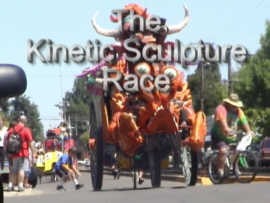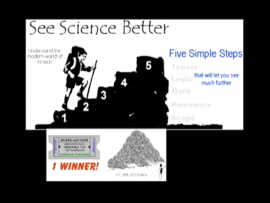
a 20-minute video tape

|
|
|
| Weird things.
Puzzling things. Wondrous things. Magic. Illusions. Deceptions. Oregonians for Rationality will set your mind to spinning at Da Vinci days in Corvallis Oregon. |

the booth is a constant hubub of activity |
| These exhibits will show you that science is not what it
seems at first glance…the world is not what it seems at first
glance.
One of the most popular demonstrations, especially with the younger visitors, is the Human Kaleidoscope, a huge prism of mirrors in an equilateral triangle that gives you a view of hundreds of yourself. It spins. It spins fast. It spins slow -- most older visitors prefer the slower. |

the popular Human Kaleidoscope (especially with the kids) 
adults prefer that it spin slower |
| Science often produces surprises. A simple pendulum, but a magnetic
pendulum moving in a complex magnetic field.
A small metal cube dropped down a small aluminum chimney. But
it takes its time falling.
Let's watch it fall in that 45 degree mirror underneath the chimney. It floats leisurely through the space inside the chimney.
|

the cube floats slowly down the chimney |
| Things are not always what they seem.
Here you see two very large machine nuts. Or do you? Let's look at that again. The eye can deceive when the mind doesn't
quite get it right.
Stare at the center of the rotating wheel. Just relax and let the hypnotic spell come over you. This "Trizonal Space Warper," invented by magician Jerry Andrus will let you see into the magic of your mind. Relax. … Relax…
Let the magic come out.
Jerry's "Paradox Box" can be made by everybody to take home. Here is a complex variation of the Paradox Box. Watch that ring move over the box. The Paradox Box is not what it seems. |

the rod is straight 
when you look at your neighbor the flesh on his face is crawling 
all the parts move in all the wrong ways |
| Puzzles can be simple; they can be complex; they can be easy; they
can be difficult. This one is simple, but it's difficult. There
are many way to make a cube from those pieces. There are many more
ways you can make it impossible to get them into a cube.
All of the puzzles can be found on the explorepdx.org website.
Just click on DaVinci Days 2003. Explorepdx will show you many ways
puzzles can give you insights into the mytsteries of science.
The infamous Monty Hall puzzle. It has puzzled many professional mathematicians. "I'm going to hide this here little ducky... "I might put that little duck in number 3, or I might put this little duck into number 2. I could put it into number 1.We can reason the correct answer. We can also see the correct answer from the statistics of the nuts in the tubes. Few people notice that most people choose the incorrect answer. The String Thing. If you've mastered your beginning physics course…forget it. It won't help you much to predict what this little wonder will do. It was invented at the Exploratorium in San Francisco, and their Web site will tell you what a couple of Nobel physicists have to say about it. Explorepdx.org will direct you there. . . and tell you where you can get one of these for yourself. |

simple but difficult 
sometimes the kids do what their parents cannot 
each person will place his filbert in one of the tubes 
the right thing to do is shown statistically 
the string does nothing right |
| .
. is the sounds from the race. No voice-over narration. |

last year it rounded up aliens from Area 51 
it carries a fleet of accordians and singers 
it must race, go in sand, in mud and in the river 
nothing is too outlandish 
the horse need not fly -- but it would help 
guess what lies ahead... 
Wet Paint in the mud 
a steel drum band is playing off to the right 
everybody wants to get into the act 
she bellyflopped, mother panicked, then "oh well" 
getting into the river is easy; getting out ??? 
Road Runner says... 
what else?! |
|
Oregonians for Rationality wants everyone to:
That's where these puzzles are leading. The illusions point out that things are not always what they seem. The magic points out that we can all be deceived; sometimes we might even deceive ourselves. The puzzles point out that answers to problems are often found in places we never thought to look… And that those answers are often of some kind we never suspected exists. |

the 6-year-old before you did it 
yes...they do fit 
impossible, you say?... PROVE IT! 
that can't be... ..."impossible" |
| This puzzle has a deep, dark secret. It's designed to deceive.
Six pieces go together to make a cube. The six-year old that just did it had no trouble. The six pieces in the box look a lot like the old Soma cube puzzle which can be put together to make a cube. But this puzzle is actually 12 pieces, the six in the front box and the six in the back box. Those in the back box are the mirror images of those in the front box. We can interchange any pair of similar, mirror-image pieces giving us a new puzzle. That's what happened here. There are twelve different puzzles, and one of that twelve has no solution. This puzzle solver had earlier solved one of the eleven that does have a solution. And then, the deception. |

I put it together a moment ago 
the SOLUTION vanished! |
| This cube puzzle involves no deception at all. It involves a
bit of simple arithmetic, and the way this puzzle solver is going about
looking for a solution shows that he understands that arithmetic.
He is guaranteed a solution, and he will find it fairly soon. It's
very easy to guarantee failure with this puzzle, and almost everyone who
doesn't first search for and discover the simple logic--the simple arithmetic--will
do what will lead to failure.
That's the move there…when he moved one of the little stick pieces, he immediately moved another one of them in a certain way. There are three of those pieces, and those three are the key…the key to solving this puzzle. Trial and error almost never works. This is a remarkable puzzle in that it is almost impossible to solve without its logical key. This smaller puzzle has the same key, but having so few pieces, its solution comes with trial and error fairly easily. Puzzles can illustrate some of the steps that can help anyone get a better and more useful grasp of science and math. |

the Cantankerous Cube 
cousin of Cantankerous |
|
Consider five good steps that have great potential for improving views of what science is. Scope - Relevance - Math - Logic - and Tensor
As we climb the steps, as our viewpoint improves, we begin to see that
some of our really great ideas are seen to have some really great problems.
|

five seldom seen secrets of science 
pseudoscience seems silly 
when seen from the steps 
a survey--and some of them are science really! |
| So what are those steps?
Step 1: Scope. Seek the truth, of course, but seek the whole truth. Take it all in. Don't just think about that winning lottery ticket. Think about the 67,394,283 losers, too…and give each and every ticket equal weight. Step 2: Relevance. Some things that attract a lot of our attention are simply irrelevant. The sun is hot, the air is hot, and people are lying out in the sun to get a tan or they're avoiding the sun to avoid getting sunburned. Temperature is irrelevant to sunlight being able to burn or tan. Ultraviolet radiation is what does the job, and the amount of ultraviolet is very dependent on the angle of the sun. For the same reason that the sky is blue. Step 3: Math. Start simple. Converting inches to meters, ounces to liters, dollars to Euros, barrels to gallons, watt-hours to BTU's, firkins to pottles. Then master some of the more powerful math. Discover the route from metaphor to math. The energy we think about most of the time is metaphor. The energy in science is math. |


|
|
Step 4: Logic. Science keep on discovering a lot of subtle--but fatal--mistakes we didn't realize that we were making.
Step 5: Tensor. Did you say tensor? Isn't that
a bed lamp?
In the Feynman Lectures on Physics, Richard Feynman suggests that most
of us will have to use tensors, sooner or later. Tensors are measurements
that aren't complete and useful until we've gathered several parts of the
measurement and put them together. Who is the biggest athlete?
The basketball coach want the tallest; the football coach wants the heaviest.
Putting them in a line by size is actually impossible…
for the same reason that organizing colors in a line is impossible.
All of those "it depends upon" things which complicate our lives make lining things up for comparisons too simpleminded. Ranking things in many dimensions is the right thing to do. |

LOGIC: the proof is elegant 
TENSOR: Richard Feynman says... 
line 'em up and see who's the biggest...?? 
can't line up colors either it's N-dmiensional |
|
So visit explorepdx.org and see what Oregonians for Rationality have been bringing to Da Vinci Days for the past four years. Then surf the explore the Physicist's Domain section of the Web site and see a little of what makes science work. It can work for you. |

the String Thing -- magic from the Exploratorium 
Jerry Andrus and his Magic of the Mind 
. |
